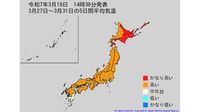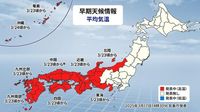The Japan Meteorological Agency (JMA) recently issued a series of forecasts detailing significant temperature fluctuations expected across the country. The agency's announcements, made on March 17 and 19, 2025, point toward an upcoming period of unusually high temperatures beginning around March 23 in several regions and continuing into late March.
Starting in Northern Japan, the forecast indicates that warmer air will start to flow in from around March 21, resulting in many days with high temperatures. Some of these days may even be considerably high. The JMA cautioned, "Caution is advised for managing crops and for thawing snow in areas with heavy snowfall." This warning highlights the crucial impact of these temperature changes on agriculture, where improper management could lead to losses.
In Eastern and Western Japan, temperatures are anticipated to remain low as lingering cold air continues to be felt until March 20, 2025. However, similar to the northern regions, warmer air is expected to arrive around March 21, leading to many days of elevated temperatures. Notably, these areas could experience considerable variability in temperature, further complicating agricultural management as farmers strive to protect their crops from unpredictable weather conditions.
Okinawa and the Amami region are set to feel colder temperatures for the next few days as the cold air persists. It is only after this period that, starting around March 24, 2025, temperatures are projected to rise significantly. Again, the JMA emphasizes, "Caution is advised for managing crops," reacting to the potential extreme temperature shifts.
The JMA further noted that they have issued early warnings due to the likelihood of exceptionally high temperatures that could occur only about once in a decade during this time of year. Specific criteria for what constitutes "considerably high temperatures" have been established, varying from region to region. For example, in the Hokuriku region, the criteria define considerably high temperatures as having a 5-day average that exceeds the norm by +2.7°C or higher.
Similarly, in the Tokai region, a 5-day average of +2.5°C or higher would be considered significantly high. Each region, including Kinki and Chugoku, has slightly different thresholds for identifying considerable heat spikes, but the overarching concern remains the same: the potential strain on local agricultural production and the disruption it could cause.
Moreover, the JMA particularly urges caution in regions that have experienced heavy snowfall. As noted, heavy snowfall is expected to lead to warnings for certain areas in the Kanto region, including Tokyo and Saitama, on March 19, 2025. The predicted cold snap until around March 20 brings with it the possibility of weather that could disrupt daily life and require residents to adapt quickly to changing conditions.
For those living on the Japan Sea side, the JMA has recommended wearing clothing that does not easily allow wind to pass through, especially as temperatures begin to rise on March 20. With strong westerly winds expected to accompany the temperature shift, residents may experience a significant difference in how warm or cold it feels depending on the wind chill factor as the temperature rises to the average for the time of year.
In summary, as Japan moves deeper into March, the significant weather fluctuations predicted by the JMA underscore the need for public vigilance. This includes careful monitoring of crop management amidst changing temperature patterns and being prepared for heavy snowfall in select regions.
With the arrival of noticeable warming, the potential for environmental impacts raises concerns about how these changes could affect agricultural activity. Farmers, consumers, and the general public should remain informed and ready to adapt as forecasts continue to evolve in the coming weeks.
Indeed, the ongoing shifts in temperature remind us that weather patterns are not only about day-to-day forecasts but also long-term implications tied to climate trends, societal readiness, and agricultural resilience.







